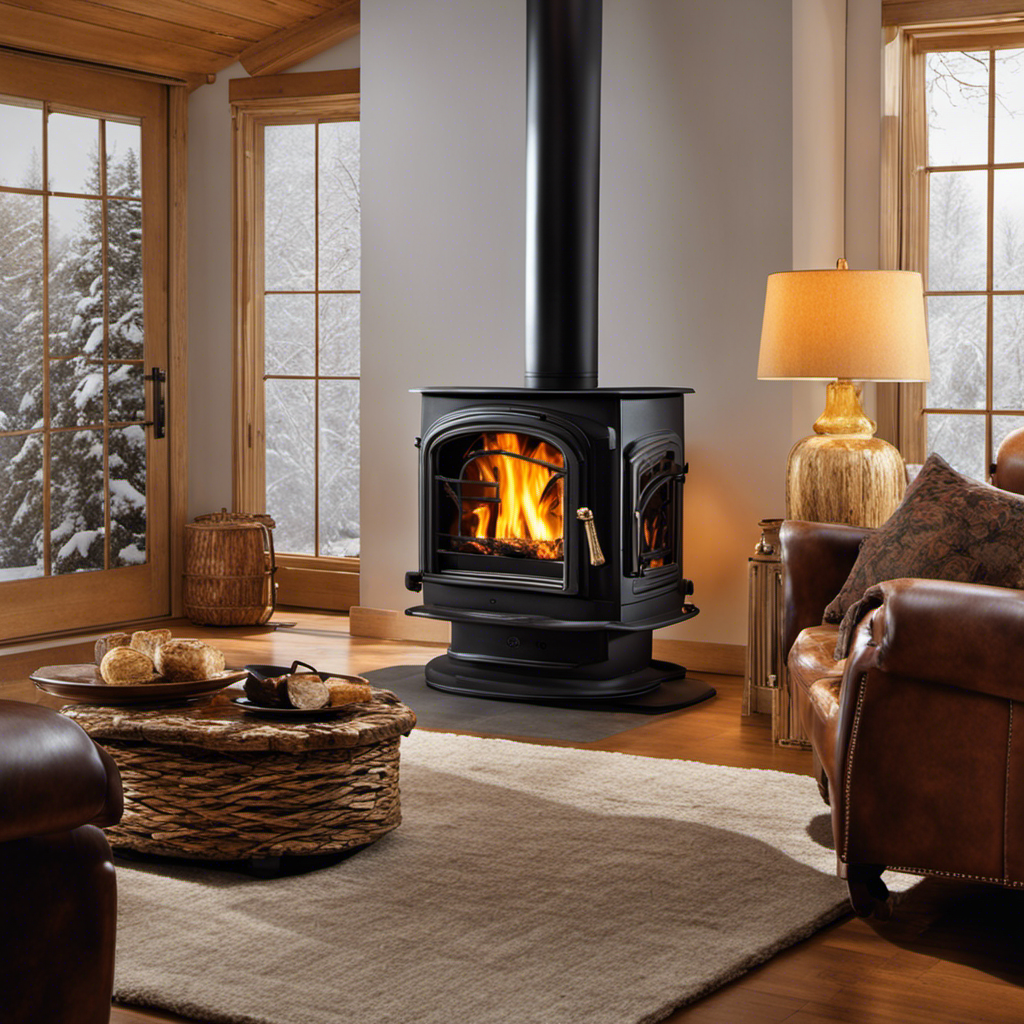Hello!
Have you ever wondered how high your wood stove chimney should be? Well, you’re in luck because I’ve got all the answers for you.
In this article, we’ll dive into the importance of chimney height and the factors that determine it. Plus, I’ll share some tips for increasing your chimney height and highlight the common issues that arise when it’s too low.
So, sit back, relax, and let’s get chimney savvy!

Key Takeaways
- Proper ventilation is crucial for carrying smoke and gases away from the stove and out of the house effectively.
- A taller chimney improves dispersion of emissions, reducing the impact on air quality.
- Meeting minimum height requirements ensures proper chimney function and prevents potential hazards.
- Insufficient chimney height can lead to poor draft and inadequate ventilation, causing smoke to backflow into the house.
The Importance of Chimney Height
I’ve learned that the height of my wood stove chimney is crucial for proper ventilation. Having the right chimney height ensures that smoke and gases are carried away from the stove and out of the house effectively.
One of the benefits of using a chimney cap is that it helps to prevent rain, snow, animals, and debris from entering the chimney. This helps to maintain the proper airflow and prevents potential blockages that could lead to poor ventilation or chimney fires.
To properly clean and maintain a chimney, it’s important to regularly remove creosote buildup, which can be done by hiring a professional chimney sweep or using specialized chimney cleaning tools. Additionally, inspecting the chimney cap for any damage or obstructions is necessary to ensure optimal functioning.
Factors That Determine Chimney Height
Based on the factors involved, it’s important to consider the height of the chimney for optimal performance. The height of a chimney is determined by various factors, including the environmental impact and safety concerns. Here are three key points to consider:

- Environmental impact of chimney height:
- A taller chimney helps improve the dispersion of emissions, reducing the impact on air quality.
- It increases the draft, allowing for better combustion and reducing the release of pollutants into the environment.
- A taller chimney can also minimize the risk of smoke entering nearby buildings or causing nuisance to neighbors.
- Safety concerns with tall chimney structures:
- Tall chimneys need to be structurally sound to withstand strong winds and seismic activity.
- The chimney height should be carefully considered to avoid potential hazards, such as interference with overhead power lines.
- Regular maintenance and inspections are crucial to ensure the safety of tall chimney structures.
Considering the environmental impact and safety concerns, determining the appropriate height for your chimney is essential for efficient and safe wood stove operation.
Minimum Height Requirements for Wood Stove Chimneys
After researching the minimum height requirements, I found that it’s crucial to meet these standards for safe and efficient operation. Following safety guidelines and building regulations is essential when it comes to wood stove chimneys.
The minimum height requirements ensure that the chimney functions properly and prevents any potential hazards. These guidelines are put in place to ensure that the chimney creates an adequate draft, allowing for efficient combustion and proper expulsion of smoke and gases.
By meeting the minimum height requirements, you can minimize the risk of smoke and carbon monoxide entering your living space.

In the next section, I’ll provide some tips for increasing chimney height to help you ensure the safety and efficiency of your wood stove.
Tips for Increasing Chimney Height
Increasing the height of a chimney can improve the safety and efficiency of the wood stove. By increasing the draft, more air can be pulled into the stove, allowing for better combustion and reducing the amount of smoke produced.
Here are three tips for increasing chimney height:
-
Install a chimney extension: Adding a section of chimney pipe on top of the existing chimney can increase its height. This can be done by attaching the extension securely to the top of the chimney.

-
Use a chimney cap: Installing a chimney cap can help create a better draft by preventing downdrafts and blockages. It can also help reduce the amount of smoke that enters your home.
-
Clear any obstructions: Make sure that the chimney is clear of any debris, such as bird nests or leaves, which can obstruct the airflow and reduce the efficiency of the chimney.
Common Issues With Inadequate Chimney Height
I often experience problems with smoke entering my home due to the insufficient height of the chimney. This is a common issue faced by many homeowners who have wood stoves. When the chimney isn’t tall enough, it can lead to poor draft and inadequate ventilation, causing smoke to backflow into the house.
In addition to the annoyance of smoke filling the living space, this can also pose health risks from inhaling the particles. To address this problem, there are a few potential solutions.

One option is to extend the chimney’s height by adding an extension or a chimney cap. This can improve the draft and prevent smoke from entering the house.
Another solution is to install a draft inducer, which helps create a stronger draft and directs the smoke out of the chimney more effectively.
Frequently Asked Questions
Can I Install My Wood Stove Chimney at a Lower Height Than the Minimum Requirements Mentioned?
I can’t install my wood stove chimney at a lower height than the minimum requirements mentioned. It’s important to follow chimney height regulations for proper ventilation and safety when installing a wood stove.
Are There Any Specific Regulations or Codes That Dictate the Height of a Wood Stove Chimney?
There are specific regulations and minimum height requirements for wood stove chimneys. These codes ensure proper ventilation and safety. It’s important to adhere to these guidelines to prevent potential hazards and ensure efficient operation.

What Are the Potential Risks or Dangers of Having a Chimney That Is Too Short?
Having a chimney that is too short can pose potential risks and dangers. It may not provide adequate ventilation, leading to poor air quality and increased risk of carbon monoxide poisoning. Following recommended guidelines and regulations is crucial to ensure a safe setup. Alternative methods should be explored if the chimney height is inadequate.
Are There Any Alternative Methods or Devices to Increase Chimney Height if My Current Setup Is Inadequate?
There are alternative methods and devices available to increase chimney height if your current setup is inadequate. These options can help improve ventilation and prevent potential risks associated with a chimney that is too short.
What Are the Potential Consequences of Not Adhering to the Recommended Chimney Height Guidelines?
Neglecting proper chimney height can lead to hazardous consequences due to inadequate ventilation. Potential dangers of a short chimney include increased risk of carbon monoxide poisoning, poor combustion, and potential chimney fires.
Conclusion
So, there you’ve it folks – the all-important question of how high your wood stove chimney needs to be. Turns out, it’s not just a matter of aesthetics or personal preference.

Nope, there are actual factors at play here, like draft efficiency and safety regulations. But fear not, for we’ve provided all the information you need to meet those minimum height requirements and even increase your chimney height if necessary.
Now go forth, dear chimney enthusiasts, and reach for the heights of wood stove perfection!
Growing up surrounded by the vast beauty of nature, Sierra was always drawn to the call of the wild. While others sought the comfort of the familiar, she ventured out, embracing the unpredictable and finding stories in the heartbeat of nature.
At the epicenter of every remarkable venture lies a dynamic team—a fusion of diverse talents, visions, and passions. The essence of Best Small Wood Stoves is crafted and refined by such a trio: Sierra, Logan, and Terra. Their collective expertise has transformed the platform into a leading authority on small wood stoves, radiating warmth and knowledge in equal measure.











